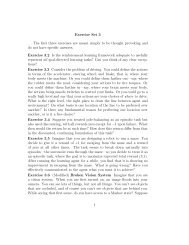Manifold Alignment without Correspondence - University of ...
Manifold Alignment without Correspondence - University of ...
Manifold Alignment without Correspondence - University of ...
Create successful ePaper yourself
Turn your PDF publications into a flip-book with our unique Google optimized e-Paper software.
defined by different features for different tasks and it is hard<br />
to find correspondences between them. This problem can be<br />
more precisely defined as follows: suppose we have two data<br />
sets X = {x 1 , · · · , x m } and Y = {y 1 , · · · , y n } for which<br />
we want to find correspondence, our aim is to compute functions<br />
α and β to map x i and y j to the same space such that<br />
α T x i and β T y j can be directly compared.<br />
To solve the problem mentioned above, the new algorithm<br />
(illustrated in Figure 1(C)) needs to go beyond the regular<br />
manifold alignment in that it should be able to map the data<br />
instances (from two different spaces) to a new lower dimensional<br />
space <strong>without</strong> using correspondence information. We<br />
also want the resulting alignment to be defined everywhere<br />
rather than just on the training instances, so that it can handle<br />
new test points. In this paper, we propose a novel approach<br />
to learn such mapping functions α and β to project<br />
the data instances to a new lower dimensional space by simultaneously<br />
matching the local geometry and preserving the<br />
neighborhood relationship within each set. In addition to the<br />
theoretical analysis <strong>of</strong> our algorithm, we also report on several<br />
real-world applications <strong>of</strong> the new alignment approach<br />
in information retrieval and bioinformatics. Notation used in<br />
this paper is defined and explained in Figure 3.<br />
The rest <strong>of</strong> this paper is as follows. In Section 2 we describe<br />
the main algorithm. In Section 3 we explain the rationality<br />
underlying our approach. We describe some novel applications<br />
and summarize experimental results in Section 4.<br />
Section 5 provides some concluding remarks.<br />
2 The Main Algorithm<br />
2.1 The Problem<br />
As defined in Figure 3, X is a set <strong>of</strong> samples collected from<br />
manifold X ; Y is a set <strong>of</strong> samples collected from manifold<br />
Y. We want to learn mappings α and β to map X and Y to a<br />
new space Z, where the neighborhood relationships inside <strong>of</strong><br />
X and Y will be preserved, and if local geometries <strong>of</strong> x i and<br />
y j are matched in the original spaces, they will be neighbors<br />
in the new space.<br />
2.2 High Level Explanation<br />
The data sets X and Y are represented by different features.<br />
Thus, it is difficult to directly compare x i and y j . To build<br />
connections between them, we use the relation between x i<br />
and its neighbors to characterize x i ’s local geometry. Using<br />
relations rather than features to represent local geometry<br />
makes the direct comparison <strong>of</strong> x i and y j be possible. However,<br />
x i might be similar to more than one instance in Y , and<br />
it is hard to identify which one is the true match (in fact, for<br />
many applications, there is more than one true match).<br />
An interesting fact is that solving the original coupled<br />
problem could be easier than only finding the true match. The<br />
reason is the structure <strong>of</strong> both manifolds need to be preserved<br />
in the alignment. This helps us get rid <strong>of</strong> many false positive<br />
matches. In our algorithm, we first identify all the possible<br />
matches for each instance leveraging its local geometry. Then<br />
we convert the alignment problem to an embedding problem<br />
with constraints. The latter can be solved by solving a generalized<br />
eigenvalue decomposition problem.<br />
x©<br />
y<br />
X<br />
Y<br />
<br />
x©<br />
y<br />
<br />
x©<br />
Figure 2: Illustration <strong>of</strong> the main algorithm.<br />
2.3 The Algorithm<br />
Assume the kernels for computing the similarity between data<br />
points in each <strong>of</strong> the two data sets are already given (for example,<br />
heat kernel). The algorithm is as follows:<br />
1. Create connections between local geometries:<br />
• W ij = e −dist(Rx i ,Ry j )/δ2 , where R xi , R yj ,<br />
and W are defined and explained in Figure 3,<br />
dist(R xi , R yj ) is defined in Sec 3.2.<br />
• The definition <strong>of</strong> W ij could be application oriented.<br />
Using other ways to define W ij does not<br />
affect the other parts <strong>of</strong> the algorithm.<br />
2. Join the two manifolds:<br />
• Compute the matrices L, Z and D, which are used<br />
to model the joint structure.<br />
3. Compute the optimal projection to reduce the dimensionality<br />
<strong>of</strong> the joint structure:<br />
• The d dimensional projection is computed by d<br />
minimum eigenvectors γ 1 · · · γ d <strong>of</strong> the generalized<br />
eigenvalue decomposition ZLZ T γ = λZDZ T γ.<br />
4. Find the correspondence between X and Y :<br />
• Let A be the top p rows <strong>of</strong> [γ 1 · · · γ d ], and B be<br />
the next q rows. For any i and j, A T x i and B T y j<br />
are in the same space and can be directly compared.<br />
The algorithm is illustrated in Figure 2. x i ∈ X and<br />
y j ∈ Y are from different manifolds, so they cannot be directly<br />
compared. Our algorithm learns a mapping A for X<br />
and a mapping B for Y to map the two manifolds to one<br />
space so that instances (from different manifolds) with similar<br />
local geometry will be mapped to similar locations and<br />
the manifold structures will also be preserved. Computing A<br />
and B is tricky. Steps 1 and 2 are in fact joining the two manifolds<br />
so that their underlying structures in common can be<br />
explored. Step 3 computes a mapping to( map the ) joint structure<br />
to a lower dimensional space, where = [γ A<br />
B<br />
1 · · · γ d ]<br />
is used for manifold alignment. Section 3 explains the rationale<br />
underlying the approach. Once A and B are available<br />
to us, AB + and BA + can be used as “keys” to translate instances<br />
between spaces defined by totally different features<br />
(for example, one is in English, another is in Chinese). The<br />
algorithm can also be used when partial correspondence information<br />
is available (see Sec 4.2 for more details).<br />
y





